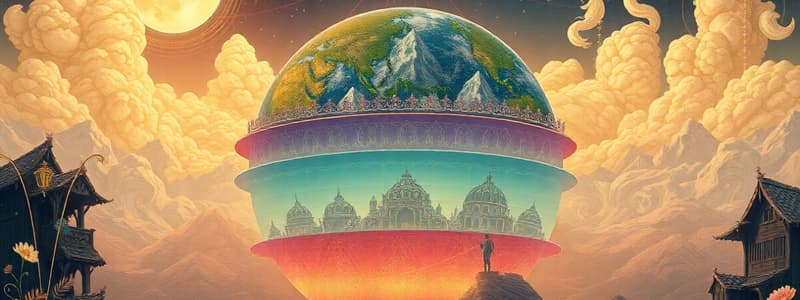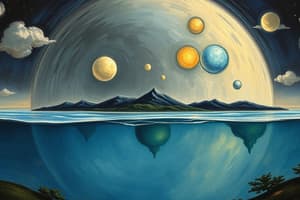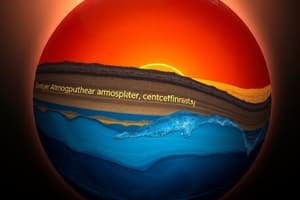Podcast
Questions and Answers
What is one main way carbon is removed from the atmosphere?
What is one main way carbon is removed from the atmosphere?
- Volcanic eruptions
- Erosion of rocks
- Photosynthesis (correct)
- Cellular respiration
Which of the following statements about the carbon cycle is true?
Which of the following statements about the carbon cycle is true?
- Volcanic eruptions reduce carbon levels in the atmosphere.
- Cellular respiration releases carbon dioxide back into the atmosphere. (correct)
- Carbon is permanently trapped in the biosphere.
- Carbon only exists in the atmosphere.
Where is most carbon commonly found in living organisms?
Where is most carbon commonly found in living organisms?
- Exclusively in the hydrosphere
- As a gas in the atmosphere
- In solid forms like rocks
- Combined with other elements in compounds (correct)
Which processes contribute to the movement of carbon in Earth’s systems?
Which processes contribute to the movement of carbon in Earth’s systems?
What is the primary source of phosphorus in the phosphorus cycle?
What is the primary source of phosphorus in the phosphorus cycle?
What impact does deforestation in rain forests have on the phosphorus cycle?
What impact does deforestation in rain forests have on the phosphorus cycle?
Which statement best describes carbon reservoirs?
Which statement best describes carbon reservoirs?
In which Earth system is phosphorus stored in large quantities within living organisms?
In which Earth system is phosphorus stored in large quantities within living organisms?
How long can the cycling of phosphorus take in the geological context?
How long can the cycling of phosphorus take in the geological context?
What form does phosphorus primarily take in the hydrosphere?
What form does phosphorus primarily take in the hydrosphere?
Which layer of the Earth System contains all of Earth's water?
Which layer of the Earth System contains all of Earth's water?
What is the primary gas composition of the atmosphere?
What is the primary gas composition of the atmosphere?
What characterizes the exosphere in relation to the other atmospheric layers?
What characterizes the exosphere in relation to the other atmospheric layers?
Which Earth System is described as the largest and includes all soil and rocks?
Which Earth System is described as the largest and includes all soil and rocks?
What process is responsible for the release of water vapor from plants and soil?
What process is responsible for the release of water vapor from plants and soil?
In which Earth System do all living things exist?
In which Earth System do all living things exist?
What is the primary function of the ionosphere?
What is the primary function of the ionosphere?
Which Earth System acts as insulation and protects from solar radiation?
Which Earth System acts as insulation and protects from solar radiation?
Which component is NOT part of the water cycle?
Which component is NOT part of the water cycle?
Which process involves the breaking down or dissolving of rocks and minerals?
Which process involves the breaking down or dissolving of rocks and minerals?
What is the process called where water vapor transforms into liquid water?
What is the process called where water vapor transforms into liquid water?
What role does the water cycle play regarding thermal energy?
What role does the water cycle play regarding thermal energy?
Which of the following is NOT a part of the Earth System?
Which of the following is NOT a part of the Earth System?
At what altitude is the ionosphere located?
At what altitude is the ionosphere located?
Which term describes the cycle involving the movement of carbon among the biosphere, atmosphere, oceans, and geosphere?
Which term describes the cycle involving the movement of carbon among the biosphere, atmosphere, oceans, and geosphere?
Which of the following is NOT one of the Earth's major cycles?
Which of the following is NOT one of the Earth's major cycles?
Which layer of the atmosphere is closest to Earth's surface?
Which layer of the atmosphere is closest to Earth's surface?
What is the primary function of the ozone layer in the stratosphere?
What is the primary function of the ozone layer in the stratosphere?
At what altitude does the stratosphere generally extend?
At what altitude does the stratosphere generally extend?
Which layer contains the majority of satellites?
Which layer contains the majority of satellites?
Which statement accurately describes the temperature gradient in the troposphere?
Which statement accurately describes the temperature gradient in the troposphere?
Which layer of the atmosphere is responsible for protecting Earth from meteors?
Which layer of the atmosphere is responsible for protecting Earth from meteors?
What feature is unique to the stratosphere compared to other atmospheric layers?
What feature is unique to the stratosphere compared to other atmospheric layers?
Which layer of the atmosphere is located directly above the mesosphere?
Which layer of the atmosphere is located directly above the mesosphere?
Study Notes
Earth System Interactions & Cycles
- The Earth System is comprised of four interconnected systems:
- Atmosphere: The thin layer of gases and particles surrounding Earth.
- Hydrosphere: All of Earth's water, mostly on the surface.
- Geosphere: The solid Earth, including the thin layer of soil and rocks on the surface and internal layers.
- Biosphere: All living things on Earth, interacting within all other systems.
Layers of the Atmosphere
- Troposphere: The layer closest to Earth's surface (8-15 km), where temperature decreases with altitude.
- Stratosphere: Directly above the troposphere (15-50 km), containing the Ozone Layer which protects Earth from the Sun's ultraviolet rays.
- Mesosphere: Directly above the stratosphere (50-85 km), protects Earth from meteors.
- Thermosphere: Directly above the mesosphere (85-500 km), the highest temperature layer, containing most satellites.
- Exosphere: The farthest layer from Earth's surface, with no definite edge, where molecules escape gravity due to high speed.
- Ionosphere: Between the mesosphere and thermosphere (60-500 km), containing ions that reflect AM radio waves.
Processes within Earth's Systems
- Water Cycle: Continuous movement of water on, above, and below Earth's surface.
- Evaporation: Liquid water changing to vapor.
- Condensation: Water vapor changing to liquid.
- Transpiration: Water vapor released from plants and soil.
- Rock Cycle: Series of processes changing rocks from one form to another.
- Weathering: Breakdown of rocks and minerals on Earth's surface.
- Erosion: Transporting broken-down rock and mineral fragments.
- Carbon Cycle: Continuously moves carbon among Earth's systems.
- Photosynthesis: Removes carbon dioxide from the atmosphere.
- Cellular respiration: Returns carbon dioxide to the atmosphere.
- Phosphorus Cycle: Moves phosphorus among Earth's systems.
- Phosphorus is a key element for all organisms, present in rocks, water, and organisms.
- Human activities, like deforestation, can disrupt the cycle.
Key Facts
- The Earth's atmosphere makes up a small fraction of the planet's total mass.
- The majority of Earth's water is saltwater, found in oceans.
- The geosphere is the largest Earth system, including internal layers and surface rocks.
- The biosphere relies on all other Earth systems for resources and survival.
Studying That Suits You
Use AI to generate personalized quizzes and flashcards to suit your learning preferences.
Related Documents
Description
This quiz explores the interconnected systems of the Earth, including the atmosphere, hydrosphere, geosphere, and biosphere. Additionally, it covers the different layers of the atmosphere, detailing their characteristics and functions. Test your understanding of Earth's systems and their interactions!




